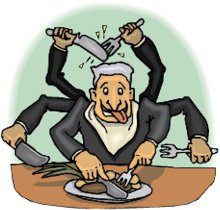The 10 Top Dining Etiquette Errors
by SixWise.com
Do you break out into a sweat the minute you sit down to a formal dinner,
faced with the challenge of picking up the proper utensil for the proper
dish, knowing that if you don't you'll appear unsophisticated, unworldly
or - worst of all - merely human?
You're not alone. The market is ripe with books and courses geared toward
helping Americans dine with ease and grace. But while dining etiquette
errors may cause only a chuckle here and there when you're among friends,
these types of blunders could cost you your next business deal if they
occur at a business lunch or dinner ... or even your inheritance if
your wealthy aunt witnesses you using a soup spoon to mix honey into your
tea!
According to Adeodata Czink, president of Business of Manners, a company
that specializes in mastering proper international protocol:
"Bad table manners are the biggest giveaway that a person lacks
manners. If you are in Europe and you don't know how to hold a fork,
that is the first thing they notice. You can fake a huge amount, but
you can't fake holding a fork."
If you avoid these top 10 dining etiquette blunders, you'll be well on
your way to being the toast of the party.
1. Not Holding Utensils Properly.
Rather than holding your fork (or spoon) in a full-fisted way, the proper
way to hold your utensil is to balance it between the first knuckle of
the middle finger and the tip of the index finger, while using the thumb
to support the handle. When you use a knife, the tip of your index finger
should rest on the upper blade of the knife.
Use the utensil that's farthest away from your plate first, then work
your way in. Use one utensil for each course (don't save your salad fork
to use with the main course, for instance).
|

Knowing which utensil to use for which course is one of the toughest
parts of formal dining. A general rule? Start from the outside and
work your way in.
|
If that's not enough to remember, there are two ways to use a knife and
fork: The American Style and the European Style, either of which can be
used.
American Style: Hold your knife in your right hand, fork in the
left. Cut a few pieces of food, place knife on the edge of your plate
(with the blade facing in), then switch your fork to your right hand to
eat (unless, of course, you're left-handed).
European Style: Hold your knife in your right hand, fork in the
left. The difference is that you don't switch hands-you eat with your
fork in your left hand, with the prongs curving downward.
2. Taking Phone Calls During a Meal.
Cell phones should NOT be answered during a meal. In the event of an
emergency, apologize beforehand for having to answer your phone, then
leave the table and talk outside of the room. Ideally, your cell phone
should not even be with you at the table, and certainly should not be
placed on the table (nor should purses, keys, wallets, etc.).
If it seems unfathomable to answer your cell phone during dinner and
like something only a teenager who doesn't know any better would do, a
study led by Robbie Blinkoff, Context research group's principal anthropologist,
found that's not the case. "Parents are just as guilty as their teenage
kids of accepting cell-phone calls during dinner," the study said.
3. Chewing With Your Mouth Open.
This is one of the quickest ways to be sure you're not invited back to
dinner. Always keep your mouth closed while you chew and try not to make
loud noises. It's acceptable to talk with a small piece of food in your
mouth, but don't attempt it if your mouth is full or close to it.
|

Avoid cutting up your entire meal all at once. Cut only a few pieces
of food at a time.
|
4. Cutting Your Food up Into Tiny Pieces/Cutting Meat up All at Once.
Proper etiquette says you should only cut a few pieces of meat/food at
a time, or, better yet, cut only the piece you plan to eat.
As for people who choose to cut their food up all at once, Czink says,
"When you cut your food up like that, you look like you are about
to feed a baby."
5. Acting Rude to Wait Staff/Servers.
Acting rude to waiters and waitresses is a good way to embarrass yourself
and others at the table. While it's fine to ask questions about the menu,
or point out if you receive the wrong dish, it's important to be polite
to everyone around. Many business deals have surely gone sour after a
company sees a rude display at the dinner table-they're likely wondering
how the person will treat their own employees!
(Plus, some of us here at SixWise.com always wonder if waiters and waitresses
"pay you back" for rudeness in ways that you can't see. Remember,
they have private exposure to your food before you do! :)
6. Expounding on Religious/Political/Dietary Beliefs.
Conversation at a formal dinner should not be offensive to those around
you. If you sense that you've crossed the line in dinner topics, such
as ranting about why you do or don't eat meat as the main course is served,
and notice others sending looks across the table at your expense, simply
change the topic as quickly as possible.
|
Top Recommended Reading
On Etiquette for Kids!
 365
Manners Kids Should Know: Games, Activities, and Other Fun Ways
to Help Children Learn Etiquette is a remarkable gift for kids
and their parents that makes learning manners fun! Among its many
riches, kids will enjoy learning: 365
Manners Kids Should Know: Games, Activities, and Other Fun Ways
to Help Children Learn Etiquette is a remarkable gift for kids
and their parents that makes learning manners fun! Among its many
riches, kids will enjoy learning:
-
How to act when a friend loses a loved one, how to be a good
neighbor, how to save a place in line
-
Table manners for the home, at restaurants, and as guests
-
How to politely sneeze, cough, belch, chew gum, and much more
-
Etiquette for introductions, departures, and more
- Email, telephone and letter etiquetter
Read
More & Order This Book Now!
|
7. Complaining About the Food.
Even if the meat is tough, the vegetables are overcooked and the bread
is stale, there's no excuse to tell this to your host. An exception would
be if you're in a restaurant, and then it's acceptable to politely ask
for a new dish.
8. Picking your teeth with a toothpick or fingers while at the table.
If food gets stuck in your teeth, excuse yourself from the table and
fish it out while in the bathroom. Be sure to wash your hands afterward.
In the case of removing an olive pit or shrimp shell from your mouth,
the general rule is to take it out the same way it went in. So, if you
ate the olive with your fingers, you can remove the pit with your fingers
as well.
Interestingly, picking your teeth is not just a dining faux pas-it also
happens to be one of the Nine
Grossest Things Other People do That can Make You Sick.
9. Using the Butter Serving Knife to Butter Your Roll.
A portion of butter should be taken from the butter dish, using the butter
knife, and placed onto your own bread plate. Break the roll into small
pieces and butter your bread a piece at a time, rather than buttering
the whole piece at once.
10. Licking Your Fingers/Using Fingers to Push Food Onto Your Fork.
Always use a napkin to remove food from your fingers, and a knife to
push food onto your fork. If the situation were reversed, would you want
to shake hands with, or take a dinner roll from, someone after their fingers
have been in their mouth or on their plate?
Sources
Business
of Manners
Common
Mistakes in Dining Etiquette
Dining
Etiquette
Wired
News
Basic
Table Manners